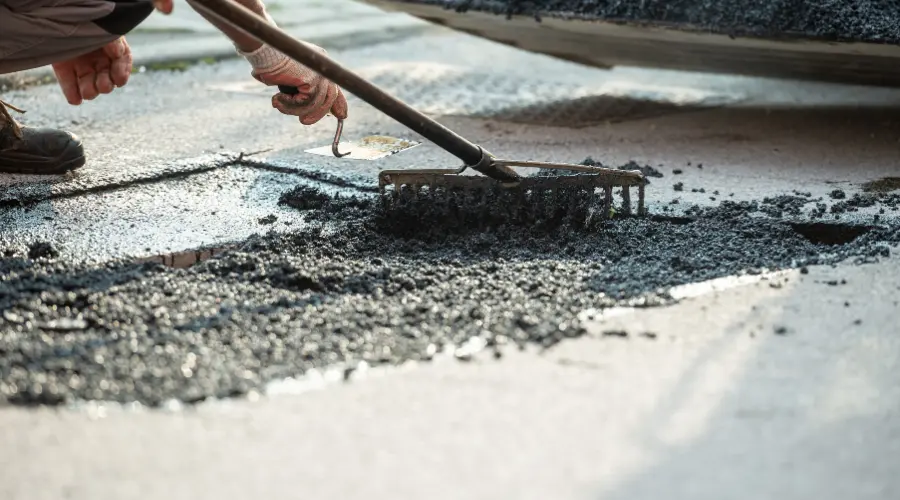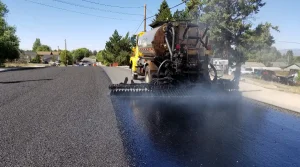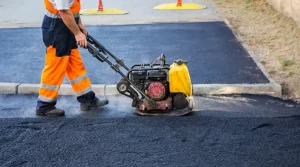Asphalt surfaces naturally degrade over time due to weather fluctuations, heavy traffic, and normal wear and tear. Hot crack repair is an essential maintenance practice to extend the lifespan of asphalt and ensure safety.
Key Takeaways
- Hot rubberized sealant is the most effective material for crack repair, offering flexibility, adhesion, and durability.
- Adhering to industry standards like ASTM D6690 ensures high-quality results.
- Proper surface preparation, skilled technicians, and timely repairs are critical for long-lasting outcomes.
- Regular maintenance saves costs in the long run by preventing major pavement issues.
Why Asphalt Cracks and the Importance of Repairs
Cracks in asphalt surfaces are caused by various factors, including:
- Weather extremes: Freeze-thaw cycles expand and contract the pavement, leading to cracks.
- Traffic loads: Continuous use by heavy vehicles weakens the asphalt.
- Aging: Over time, asphalt oxidizes, becoming brittle and prone to cracking.
Unrepaired cracks allow water to seep in, causing further damage and potentially leading to potholes and structural failures. Addressing cracks promptly through hot crack repair prevents these issues and significantly extends the life of the pavement.
Procedures of Asphalt Crack Repairs
1. Assessment
Begin with a thorough inspection to determine the severity and types of cracks:
- Transverse cracks: Perpendicular to the pavement’s centerline.
- Longitudinal cracks: Run parallel to the centerline.
- Block cracks: Interconnected cracks forming a grid pattern.
Prioritize repairs based on the severity and impact on the pavement’s structural integrity.
2. Cleaning
Proper cleaning is crucial for sealant adhesion:
- Remove debris, vegetation, and dirt using high-pressure air, wire brushes, or specialized equipment.
- Ensure the cracks are dry to prevent moisture interference.
3. Routing
Routing involves widening and deepening the cracks to create a uniform reservoir for the sealant. This step enhances the sealant’s durability by providing more surface area for bonding.
4. Heating
Use hot air lances or infrared heaters to remove residual moisture and improve sealant adhesion. Heating also softens the asphalt, enabling better integration of the sealant.
5. Sealing
Apply hot rubberized crack sealant with a specialized applicator. Ensure the sealant completely fills the crack and creates a tight bond with the surrounding asphalt.
6. Cooling
Allow the sealant to cool and solidify. The resulting flexible bond expands and contracts with temperature changes, ensuring durability.
Best Way to Seal Cracks in Asphalt
Hot rubberized crack sealant is the gold standard for asphalt crack repair due to its:
- Flexibility: Adapts to temperature-induced expansion and contraction.
- Superior adhesion: Bonds strongly with asphalt surfaces.
- Durability: Resists water penetration, UV damage, and wear from traffic.
Standards for Crack Sealing
Adhering to recognized industry standards ensures high-quality results:
- ASTM D6690: Specifications for hot-applied, single-component sealants.
- ASTM D5078: Guidelines for asphalt crack sealants.
- FHWA-RD-99-147: Federal Highway Administration guidelines for selecting crack sealing treatments.
These standards ensure the materials and methods meet durability and performance criteria.
Guidelines and Recommendations for Effective Hot Crack Repair
Follow these best practices to achieve optimal results:
1. Thorough Surface Preparation
- Ensure cracks and surrounding areas are free from contaminants like debris and moisture.
- Use high-quality cleaning equipment for maximum efficiency.
2. Precise Application Methods
- Heat the sealant to the manufacturer’s recommended temperature.
- Apply uniformly to avoid gaps or excess material.
3. Quality Assurance Procedures
- Regularly inspect equipment for proper functionality.
- Monitor the application process to ensure consistency and accuracy.
6 Best Practices for Hot Crack Repair
- Timely Maintenance: Repair cracks promptly to prevent further deterioration.
- Use Premium Materials: Invest in high-quality, industry-approved hot rubberized sealants.
- Employ Specialized Equipment: Utilize machines designed for hot crack repair to achieve superior outcomes.
- Hire Skilled Technicians: Ensure workers are trained in proper sealing techniques and safety protocols.
- Consider Weather Conditions: Schedule repairs when the pavement is dry, and temperatures are moderate.
- Establish Regular Maintenance: Conduct routine inspections and repairs to avoid escalating issues.
Benefits of Hot Crack Repair
- Enhanced Longevity: Prevents water infiltration and structural damage.
- Cost Savings: Regular maintenance is more affordable than major repairs or resurfacing.
- Improved Safety: Eliminates tripping hazards and enhances road safety.
- Aesthetic Appeal: Restores the smooth appearance of asphalt surfaces.
Frequently Asked Questions (FAQ)
1. Why is hot crack repair better than cold patching?
Hot crack repair uses rubberized sealants that create a durable, flexible bond capable of withstanding temperature changes and heavy traffic. Cold patching is more temporary and less effective for long-term repairs.
2. When is the best time to perform crack sealing?
The ideal time is during dry weather with moderate temperatures (spring or fall). Avoid sealing during rainy or freezing conditions.
3. How long does the repair process take?
The duration depends on the extent of the cracks and the pavement area. However, most projects can be completed within a day, and the pavement is typically ready for use within hours.
4. Can hot crack repair be performed on all types of cracks?
Hot crack repair is effective for transverse, longitudinal, and block cracks. However, extensive damage like alligator cracking may require more comprehensive solutions, such as resurfacing.
5. How often should asphalt be inspected for cracks?
Conduct inspections at least twice a year—preferably in spring and fall—to identify and address cracks early.
6. Is DIY crack repair recommended?
DIY crack repair can work for minor surface cracks, but professional hot crack repair is recommended for deeper or more extensive damage to ensure long-lasting results.
7. How much does hot crack repair cost?
Costs vary depending on the size and severity of the damage. On average, hot crack repair is a cost-effective option compared to major repairs or resurfacing.
8. What happens if cracks are left untreated?
Untreated cracks allow water to penetrate the pavement, leading to potholes, erosion, and structural failures, ultimately requiring more expensive repairs.
Conclusion
Hot crack repair is a critical maintenance practice that ensures asphalt pavements remain durable, safe, and visually appealing. By following proper procedures, using high-quality materials, and adhering to industry standards, you can achieve long-lasting results that save time and money in the long run.
At Paving Hackensack, we specialize in asphalt repair and maintenance, offering top-notch services tailored to your needs. Whether it’s residential or commercial, we’re here to help. Contact us today for reliable hot crack repair services in Hackensack, New Jersey!







